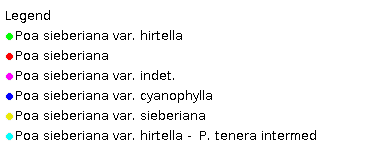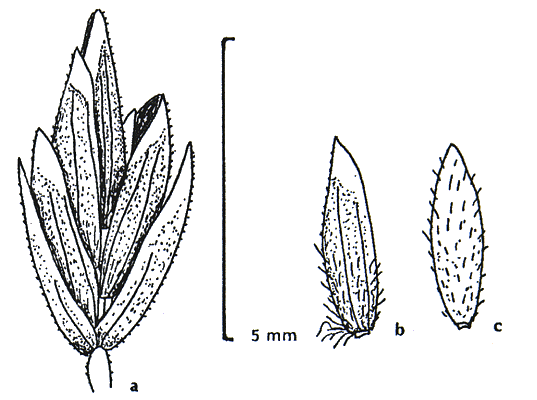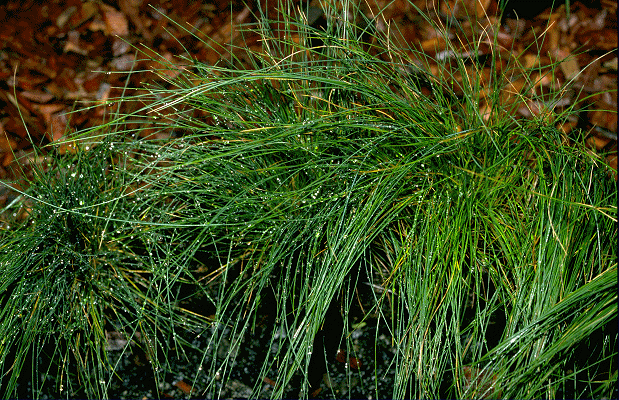Poa sieberiana Spreng. Syst.Veg.Cur.Post.35(1827).
Classification. (GPWG 2001) : Subfamily Pooideae.
Tribe Poeae.
Type of Basionym or
Protologue Information: Australia: "Nov. Holl. (P. asutralis Nees in
Sieber agrost. n. 77)", Sieber 77; IT: (IT: BM, GOET-2401, K, MEL,
MO).
Recent synonyms:
P. australis auct.
Key references
(books and floras): [2002] D.Sharp & B.K.Simon, AusGrass, Grasses of
Australia, [2006] J.Jessop, G.R.M.Dashorst, F.M.James, Grasses of South
Australia (158), [2008] S.W.L.Jacobs, R.D.B.Walley & D.J.B.Wheeler, Grasses
of New South Wales (354), [2009] A.Wilson (ed.). Flora of Australia,
Vol 44A. Poaceae 2 (319, 320&321 as var. sieberiana, var. cyanophylla,
ana var. hirtella).
Illustrations:
[2006] J.Jessop, G.R.M.Dashorst, F.M.James, Grasses of South Australia (158, fig. 111 as var. sieberiana),
[2008] S.W.L.Jacobs, R.D.B.Whalley & D.J.B.Wheeler, Grasses of New South
Wales, 4th edn (354), [2009]. A.Wilson (ed.), Flora of Australia 44A:
Poaceae 2 (323, Fig. 43 as var. sieberiana, as var. hirtella).
Habit.
Perennial. Stolons absent or present. Culms erect or geniculately ascending,
9–80 cm tall. Lateral branches simple or branched. Leaves mostly basal.
Leaf-sheaths smooth or scaberulous, glabrous on surface. Ligule a fringed
membrane, a ciliolate membrane, 0.1–2 mm long, abaxially glabrous or abaxially
scaberulous or abaxially hairy, truncate. Leaf-blades straight or curved or
flexuous, filiform, conduplicate or involute, 2.5–60 cm long, 0.2–0.7 mm wide.
Leaf-blade surface scabrous, glabrous or indumented.
Inflorescence.
Inflorescence compound, a panicle. Panicle pyramidal, 1.5–20 cm long.
Spikelets.
Spikelets pedicelled. Fertile spikelets many flowered, with at least 2 fertile
florets (2–7), comprising 2–7 fertile floret(s), with diminished florets at the
apex, ovate, laterally compressed, 2.8–8 mm long.
Glumes. Glumes
similar. Lower glume ovate, membranous, keeled, 1-keeled, 1–3 -nerved. Upper
glume ovate, 2–3 mm long, membranous, keeled, 1-keeled, 3 -nerved. Upper glume
surface smooth or asperulous.
Florets.
Fertile lemma (1.8–)2.2–3.2 mm long, keeled, 5 -nerved. Lemma surface
indumented. Lodicules present. Anthers 3. Grain 1.5 mm long.
Continental
Distribution: Australasia.
Australian
Distribution: Queensland, New South Wales, Victoria, Tasmania.
Queensland:
Darling Downs, Moreton. New South Wales: North Coast, Central Coast,
South Coast, Northern Tablelands, Central Tablelands, Southern Tablelands,
North-Western Slopes, Central-Western Slopes, South-Western Slopes,
North-Western Plains, South-Western Plains. Victoria: East Gippsland,
Eastern Highlands, Gippsland Highlands, Gippsland Plain, Grampians, Lowan
Mallee, Midlands, Otway Plain, Otway Range, Wilsons Promontory, Riverina,
Snowfields, Volcanic Plain, Wannon, Wimmera. Tasmania: North West, North
East, West Coast, Central Highlands, Ben Lomond, East Coast, South West.
Notes. Endemic.
Infra-specific
taxa: var. sieberiana, var. cyanophylla, var. hirtella.
1.Spikelets 4.3–5.7 mm
long, stiff P. sieberiana var. sieberiana
Spikelets 3–3.4 mm long, not stiff 2
2.Leaf blades 25 mm
long, adaxially glabrous P. sieberiana var. cyanophylla
Leaf blades 80–340 mm long, adaxially
puberulous P. sieberiana var. hirtella






